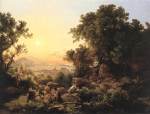

Masters of ideal landscape do not attempt to portray landscape accurately. Although artists observed elements of the landscape, they, however, united details taken from various locations in order to co-ordinate individual elements to best match messages.
The ideal landscape which was intended to express a unity of atmosphere and perfect visual harmony was subordinated to academic laws to be respected by all artists. Thus, three areas of space had to be created, motifs on the left and the right, and motifs attracting the eye to the back had to be considered, too. There was a shadowy, less accented foreground which followed the main theme, a strongly lit central plain where scenes taken over from mythology, the Bible and history represented the content of the landscape with staffage-figures to indicate scale. The idyllic, moral or bucolic message is stressed by ruins from ancient times, splendid buildings of the artist's fantasy, huge trees or rocks to emphasise the distance between the idyllic world and the age of the viewer. The third plain with rich foliage lost in infinity and a grandiose canopy of the heavens is a lofty background to effective compositions.
The most significant representative of Hungarian ideal landscape painting was Károly Markó the Elder, a characteristic example being Diana at the Hunt from 1833.